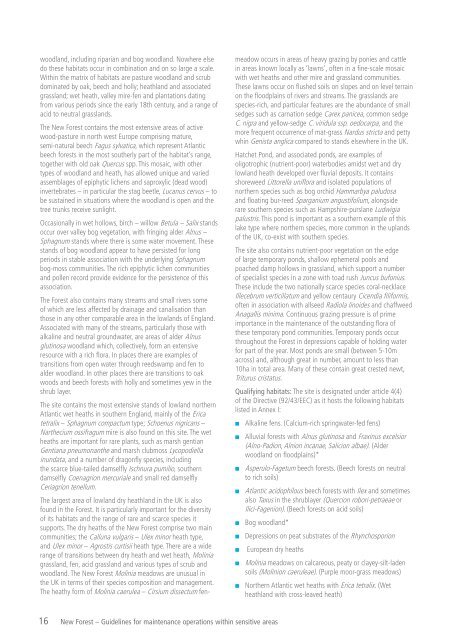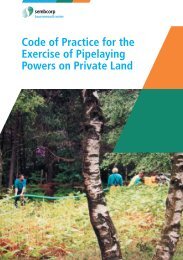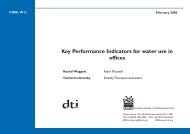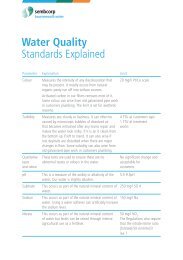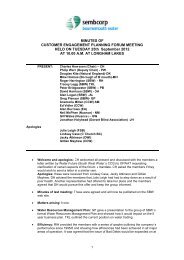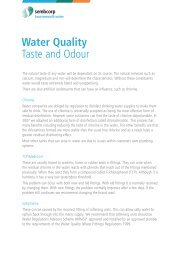New Forest - Sembcorp Bournemouth Water
New Forest - Sembcorp Bournemouth Water
New Forest - Sembcorp Bournemouth Water
- No tags were found...
Create successful ePaper yourself
Turn your PDF publications into a flip-book with our unique Google optimized e-Paper software.
woodland, including riparian and bog woodland. Nowhere elsedo these habitats occur in combination and on so large a scale.Within the matrix of habitats are pasture woodland and scrubdominated by oak, beech and holly; heathland and associatedgrassland; wet heath, valley mire-fen and plantations datingfrom various periods since the early 18th century, and a range ofacid to neutral grasslands.The <strong>New</strong> <strong>Forest</strong> contains the most extensive areas of activewood-pasture in north west Europe comprising mature,semi-natural beech Fagus sylvatica, which represent Atlanticbeech forests in the most southerly part of the habitat’s range,together with old oak Quercus spp. This mosaic, with othertypes of woodland and heath, has allowed unique and variedassemblages of epiphytic lichens and saproxylic (dead wood)invertebrates – in particular the stag beetle, Lucanus cervus – tobe sustained in situations where the woodland is open and thetree trunks receive sunlight.Occasionally in wet hollows, birch – willow Betula – Salix standsoccur over valley bog vegetation, with fringing alder Alnus –Sphagnum stands where there is some water movement. Thesestands of bog woodland appear to have persisted for longperiods in stable association with the underlying Sphagnumbog-moss communities. The rich epiphytic lichen communitiesand pollen record provide evidence for the persistence of thisassociation.The <strong>Forest</strong> also contains many streams and small rivers someof which are less affected by drainage and canalisation thanthose in any other comparable area in the lowlands of England.Associated with many of the streams, particularly those withalkaline and neutral groundwater, are areas of alder Alnusglutinosa woodland which, collectively, form an extensiveresource with a rich flora. In places there are examples oftransitions from open water through reedswamp and fen toalder woodland. In other places there are transitions to oakwoods and beech forests with holly and sometimes yew in theshrub layer.The site contains the most extensive stands of lowland northernAtlantic wet heaths in southern England, mainly of the Ericatetralix – Sphagnum compactum type; Schoenus nigricans –Narthecium ossifragum mire is also found on this site. The wetheaths are important for rare plants, such as marsh gentianGentiana pneumonanthe and marsh clubmoss Lycopodiellainundata, and a number of dragonfly species, includingthe scarce blue-tailed damselfly Ischnura pumilio, southerndamselfly Coenagrion mercuriale and small red damselflyCeriagrion tenellum.The largest area of lowland dry heathland in the UK is alsofound in the <strong>Forest</strong>. It is particularly important for the diversityof its habitats and the range of rare and scarce species itsupports. The dry heaths of the <strong>New</strong> <strong>Forest</strong> comprise two maincommunities; the Calluna vulgaris – Ulex minor heath type,and Ulex minor – Agrostis curtisii heath type. There are a widerange of transitions between dry heath and wet heath, Moliniagrassland, fen, acid grassland and various types of scrub andwoodland. The <strong>New</strong> <strong>Forest</strong> Molinia meadows are unusual inthe UK in terms of their species composition and management.The heathy form of Molinia caerulea – Cirsium dissectum fenmeadowoccurs in areas of heavy grazing by ponies and cattlein areas known locally as ‘lawns’, often in a fine-scale mosaicwith wet heaths and other mire and grassland communities.These lawns occur on flushed soils on slopes and on level terrainon the floodplains of rivers and streams. The grasslands arespecies-rich, and particular features are the abundance of smallsedges such as carnation sedge Carex panicea, common sedgeC. nigra and yellow-sedge C. viridula ssp. oedocarpa, and themore frequent occurrence of mat-grass Nardus stricta and pettywhin Genista anglica compared to stands elsewhere in the UK.Hatchet Pond, and associated ponds, are examples ofoligotrophic (nutrient-poor) waterbodies amidst wet and drylowland heath developed over fluvial deposits. It containsshoreweed Littorella uniflora and isolated populations ofnorthern species such as bog orchid Hammarbya paludosaand floating bur-reed Sparganium angustifolium, alongsiderare southern species such as Hampshire-purslane Ludwigiapalustris. This pond is important as a southern example of thislake type where northern species, more common in the uplandsof the UK, co-exist with southern species.The site also contains nutrient-poor vegetation on the edgeof large temporary ponds, shallow ephemeral pools andpoached damp hollows in grassland, which support a numberof specialist species in a zone with toad rush Juncus bufonius.These include the two nationally scarce species coral-necklaceIllecebrum verticillatum and yellow centaury Cicendia filiformis,often in association with allseed Radiola linoides and chaffweedAnagallis minima. Continuous grazing pressure is of primeimportance in the maintenance of the outstanding flora ofthese temporary pond communities. Temporary ponds occurthroughout the <strong>Forest</strong> in depressions capable of holding waterfor part of the year. Most ponds are small (between 5-10macross) and, although great in number, amount to less than10ha in total area. Many of these contain great crested newt,Triturus cristatus.Qualifying habitats: The site is designated under article 4(4)of the Directive (92/43/EEC) as it hosts the following habitatslisted in Annex I:■ Alkaline fens. (Calcium-rich springwater-fed fens)■ Alluvial forests with Alnus glutinosa and Fraxinus excelsior(Alno-Padion, Alnion incanae, Salicion albae). (Alderwoodland on floodplains)*■ Asperulo-Fagetum beech forests. (Beech forests on neutralto rich soils)■ Atlantic acidophilous beech forests with Ilex and sometimesalso Taxus in the shrublayer (Quercion robori-petraeae orIlici-Fagenion). (Beech forests on acid soils)■ Bog woodland*■ Depressions on peat substrates of the Rhynchosporion■European dry heaths■ Molinia meadows on calcareous, peaty or clayey-silt-ladensoils (Molinion caeruleae). (Purple moor-grass meadows)■ Northern Atlantic wet heaths with Erica tetralix. (Wetheathland with cross-leaved heath)16 <strong>New</strong> <strong>Forest</strong> – Guidelines for maintenance operations within sensitive areas


